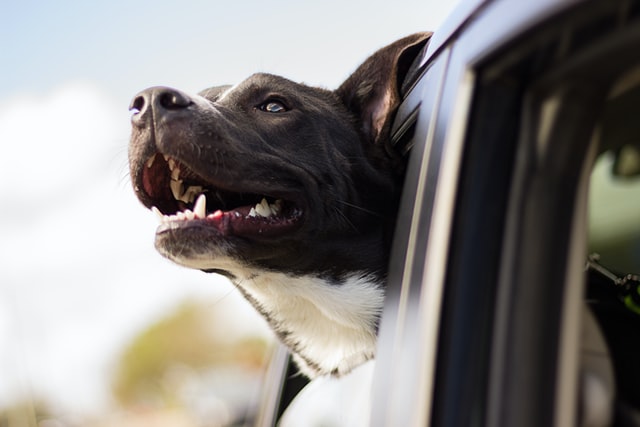If you are moving you probably already feel the stresses of moving, but have you thought about what your four-legged family member may be feeling? Pets do feel the stresses of a move and often even more stress than their human companions are feeling. Imagine: you can’t read, understand all of the chatter around you and all you see is the chaos of boxes. Your home is in an upheaval plus there are stressed out humans everywhere. Sounds even more stressful, right? That’s why it is vital to take special care of your furry friends during the moving process.
Moving doesn’t have to be a dog-gone cat-astrophy. The good news is that with a paw-ful of wise tips you can ease the trauma on your pets. Here are ten tricks to keep Fluffy and Fido cared for during the moving process:
Before Moving Day
Become familiar with pet rules and regulations. Landlords and homeowners’ associations may have specific pet rules. Become familiar with your new area’s leash laws, pet ordinances, and/or pet licensing requirements. Your pet may need additional vaccinations, medications, or certain certificates depending on where you are moving. A call to the local animal control facility should answer your questions. Follow tips to take care of your pet.
Talk To Your Current Vet: Your veterinarian is a great resource. If you have an animal that dislikes traveling, your vet can suggest behavior modification techniques or medication that can make traveling less stressful for your pet. When talking to your vet, also discuss getting Fluffy or Fido micro-chipped, a vital step in reuniting pets with their owners. Make sure the pet’s microchip information is tied to a cell phone number that will move with you.
Find A New Vet: Find a new vet in your new area before moving day. Your current vet may be able to make recommendations for colleagues he or she knows in your new area. When finding a new vet, it is recommended to set up an appointment as soon as you move in order to get established. It always important to make sure you are comfortable with their practice before they are needed in an emergency.
Get Medical Records: Before you leave your old home, make sure you get a copy of all of your pet’s medical records to give to your new vet, be sure to find the closest emergency animal hospital and keep that phone number handy.
Update Your Address: Don’t forget to have new identification tags with your new address and phone number made for your pet’s collar, and if your pet has an identification microchip, remember to update your contact information in the database.
Keep Things Normal: Instead of pulling an all-nighter to pack, try to pack over a long period of time so that your pet thinks everything is normal. This will keep their stress level down. If you are moving with cats, it can help to bring out their carriers a few weeks before the move. Put their favorite treats and toys inside their carriers so they can get used to them before the big moving day. Don’t pack the food away! Keep your pet’s food, water, bowls, medication, and any other important supplies (like that favorite squeaky toy) off the moving truck and with you.
Pet-friendly location: Check if the destination in which you are arriving is pet friendly. Ask for the rules of the location, and see if they have special requirements, sometimes even if it’s pet friendly they have some rules. You will want to see it before the move as you know your pet will be well received and avoid discomfort, penalties, or other consequences.
On Moving Day
During the actual moving day, when boxes and furniture are being moved, pets should be removed. Find a friend who wouldn’t mind pet sitting or find a place away from all the noise of moving such as a doggy day care or cat care center. If you can visit them during a spare moment, it can help reassure the pets that nothing is going on. Keeping pets locked away in a room during moving day can make them anxious from all the noise and new people that might be in your home. If you must keep them locked away, find a quiet room, a water bowl, and put a HUGE sign on the door.
Travel with Your Pet
Pets can enjoy a journey if they feel comfortable and more likely if they come with you, always try to personally escort your pet to the new destination for their safety. There are some tips you need to take in mind depending on the transportation you choose to go. But in any case, make sure to prepare a kit for your dog with a collar, a toy, and medications if the vet told you so.
Car travel: Unless your move is long distance or international, your pet will likely be traveling by car with you nearby. By driving them yourself you can care for them and give them a sense of familiarity and affection as they move. To prepare your pet for this trip, drive for short distances with your pet to prepare them before the final move. Also, remember to plan ahead for any special carriers your pets may need for transportation. There are even special seat belts for large dogs.
Air Travel: If you are moving your pet by air, check all rules and regulations far ahead of the day you plan to leave as depending on the destination you might need different paperwork, and remember to keep your pet’s special documentation at hand. In case of a larger breed, be sure to book one of the airlines that allows large dogs. Make sure to buy a carrier that best suits your pet and that is well ventilated if your pet has never been in a carrier before make sure it doesn’t get to anxious with your l love and support.
After Moving Day
Don’t let pets roam around the neighborhood until they are acclimated. Take them out on a leash to explore their new territory and show them how to get home. If you let them out in a new place right away, they might get lost or run away due to stress. Make sure your pet’s new identification tags are secured to their collar.
How to help your pet acclimated to a new space?
Designate an area of your house as a dog play area and fill it with as many enrichment activities as possible. This is an excellent way to create a safe place for your pet while they are getting used to the new space. If your dog tends to wander, you can use a safety gate to cordon off the area but be sure they have sufficient toys and activities to stay active for the entire time you keep them in the play area. Individual dogs have their own personalities and some are more adaptable than others. Not only is it important to make sure the pet you choose is a good fit for you but also that you and your environment are a good fit for them. This is something, Petsies, the custom pet plush company knows a good deal about. From custom pet blankets to felt pet ornaments, they have something for every pet lover and their home.
Niki Solomon Petsies
This is a guest post from Laura McHolm, an organizational, moving & storage expert and co-founder of NorthStar Moving Company. NorthStar Moving Company is an award-winning, “A+” rated company, which specializes in providing eco-luxury moving and storage services.




